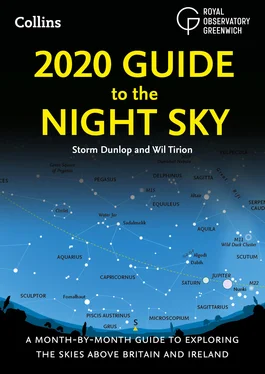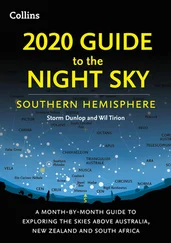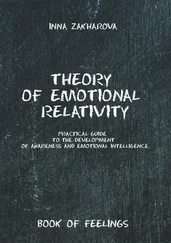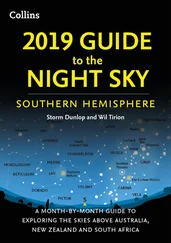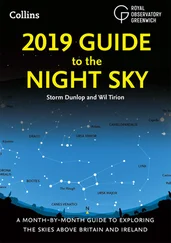The ecliptic and the zodiac
Another important line on the celestial sphere is the Sun’s apparent path against the background stars – in reality the result of the Earth’s orbit around the Sun. This is known as the ecliptic. The point where the Sun, apparently moving along the ecliptic, crosses the celestial equator from south to north is known as the vernal (or spring) equinox, which occurs on March 20. At this time (and at the autumnal equinox, on September 22 or 23, when the Sun crosses the celestial equator from north to south) day and night are almost exactly equal in length. (There is a slight difference, but that need not concern us here.) The vernal equinox is currently located in the constellation of Pisces, and is important in astronomy because it defines the zero point for a system of celestial coordinates, which is, however, not used in this Guide.
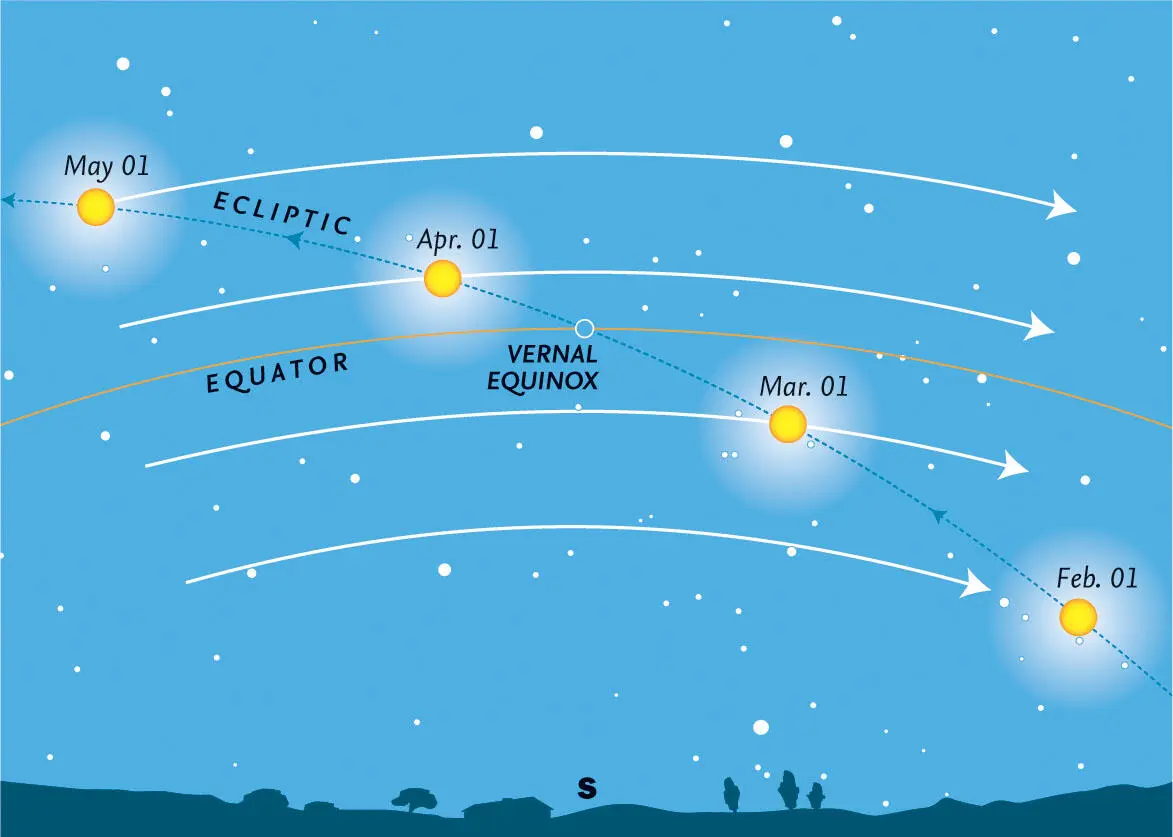
The Sun crossing the celestial equator in spring.
The Moon and planets are to be found in a band of sky that extends 8° on either side of the ecliptic. This is because the orbits of the Moon and planets are inclined at various angles to the ecliptic (i.e., to the plane of the Earth’s orbit). This band of sky is known as the zodiacand, when originally devised, consisted of twelve constellations, all of which were considered to be exactly 30° wide. When the constellation boundaries were formally established by the International Astronomical Union in 1930, the exact extent of most constellations was altered and, nowadays, the ecliptic passes through thirteen constellations. Because of the boundary changes, the Moon and planets may actually pass through several other constellations that are adjacent to the original twelve.
The constellations
Since ancient times, the celestial sphere has been divided into various constellations, most dating back to antiquity and usually associated with certain myths or legendary people and animals. Nowadays, the boundaries of the constellations have been fixed by international agreement and their names (in Latin) are largely derived from Greek or Roman originals. Some of the names of the most prominent stars are of Greek or Roman origin, but many are derived from Arabic names. Many bright stars have no individual names and, for many years, stars were identified by terms such as ‘the star in Hercules’ right foot’. A more sensible scheme was introduced by the German astronomer Johannes Bayer in the early seventeenth century. Following his scheme – which is still used today – most of the brightest stars are identified by a Greek letter followed by the genitive form of the constellation’s Latin name. An example is the Pole Star, also known as Polaris and α Ursae Minoris (abbreviated α UMi). The Greek alphabet is shown here with a list of all the constellations that may be seen from latitude 50°N, together with abbreviations, their genitive forms and English names. Other naming schemes exist for fainter stars, but are not used in this book.
Asterisms
Apart from the constellations (88 of which cover the whole sky), certain groups of stars, which may form a part of a larger constellation or cross several constellations, are readily recognizable and have been given individual names. These groups are known as asterisms, and the most famous (and well-known) is the ‘Plough’, the common name for the seven brightest stars in the constellation of Ursa Major, the Great Bear. The names and details of some asterisms mentioned in this book are given in the list here.
Magnitudes
The brightness of a star, planet or other body is frequently given in magnitudes(mag.). This is a mathematically defined scale where larger numbers indicate a fainter object. The scale extends beyond the zero point to negative numbers for very bright objects. (Sirius, the brightest star in the sky is mag. -1.4.) Most observers are able to see stars to about mag. 6, under very clear skies.
The Moon
Although the daily rotation of the Earth carries the sky from east to west, the Moon gradually moves eastwards by approximately its diameter (about half a degree) in an hour. Normally, in its orbit around the Earth, the Moon passes above or below the direct line between Earth and Sun (at New Moon) or outside the area obscured by the Earth’s shadow (at Full Moon). Occasionally, however, the three bodies are more-or-less perfectly aligned to give an eclipse: a solar eclipse at New Moon or a lunar eclipse at Full Moon. Depending on the exact circumstances, a solar eclipse may be merely partial (when the Moon does not cover the whole of the Sun’s disk); annular (when the Moon is too far from Earth in its orbit to appear large enough to hide the whole of the Sun); or total. Total and annular eclipses are visible from very restricted areas of the Earth, but partial eclipses are normally visible over a wider area.
Somewhat similarly, at a lunar eclipse, the Moon may pass through the outer zone of the Earth’s shadow, the penumbra(in a penumbral eclipse, which is not generally perceptible to the naked eye), so that just part of the Moon is within the darkest part of the Earth’s shadow, the umbra(in a partial eclipse); or completely within the umbra (in a total eclipse). Unlike solar eclipses, lunar eclipses are visible from large areas of the Earth.
Occasionally, as it moves across the sky, the Moon passes between the Earth and individual planets or distant stars, giving rise to an occultation. As with solar eclipses, such occultations are visible from restricted areas of the world.
The planets
Because the planets are always moving against the background stars, they are treated in some detail in the monthly pages and information is given when they are close to other planets, the Moon or any of five bright stars that lie near the ecliptic. Such events are known as appulsesor, more frequently, as conjunctions. (There are technical differences in the way these terms are defined – and should be used – in astronomy, but these need not concern us here.) The positions of the planets are shown for every month on a special chart of the ecliptic.
The term conjunction is also used when a planet is either directly behind or in front of the Sun, as seen from Earth. (Under normal circumstances it will then be invisible.) The conditions of most favourable visibility depend on whether the planet is one of the two known as inferior planets(Mercury and Venus) or one of the three superior planets(Mars, Jupiter and Saturn) that are covered in detail. (Some details of the fainter superior planets, Uranus and Neptune, are included in this Guide, and special charts are given here.)
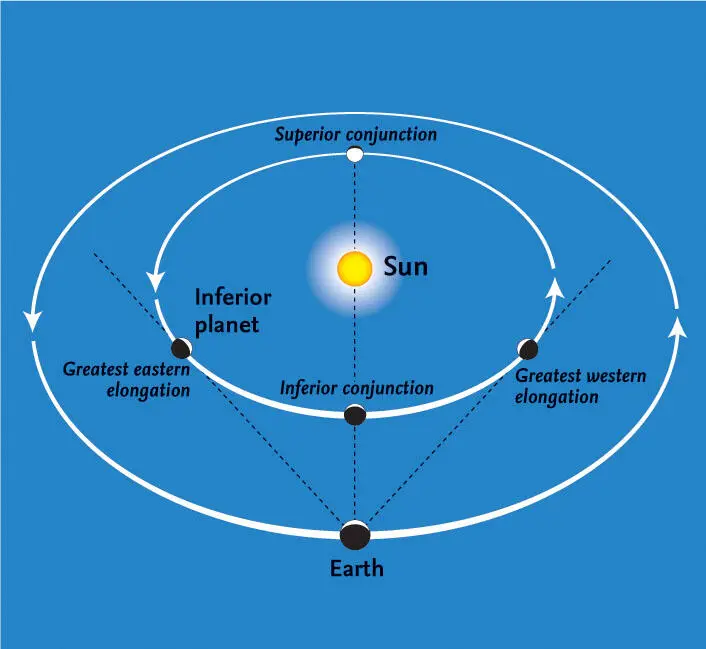
Inferior planet.
The inferior planets are most readily seen at eastern or western elongation, when their angular distance from the Sun is greatest. For superior planets, they are best seen at opposition, when they are directly opposite the Sun in the sky, and cross the meridian at local midnight.
It is often useful to be able to estimate angles on the sky, and approximate values may be obtained by holding one hand at arm’s length. The various angles are shown in the diagram, together with the separations of the various stars in the Plough.
Читать дальше
